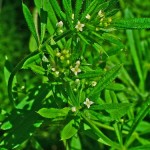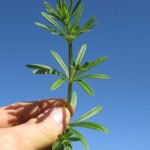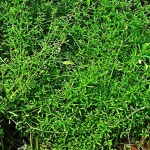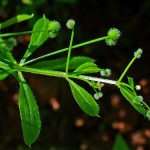Cleavers Herb – Galium aparine
|
Current Demand = Normal |
Parts Used: Herb |
 |
 |
 |
 |
Family: Rubiaceae
Common Names: Bedstraw, Catchweed, Clabber Grass, Clivers, Cleavers, Coachweed, Gravel Grass, Goose Grass, Goose Hair, Milk Sweet, Poor Robin, Loveman, Sweethearts…
Description:
This straggling annual, is found along hedgerows, woods, fields, and spread randomly among cultivated crops. The stems and leaves have little hooked bristles that cling to passersby. It climbs through dense undergrowth into the sunlight, creating dense undergrowth. The leaves are narrow, rough and slightly hairy. They form whorls of 6-9 leaves. The flowers are tiny and white about 1/16 and “star-like” and grow in clusters of 6-8 blooming separately along the leaf axils. There are flowers and seeds in each cluster. The seeds are little round vessels covered with hooked bristle and readily cling to whatever they touch. The flowers bloom April thru September.
Cultivation:
Cleavers is very easy to cultivate it prefers a loose moist leafy soil in partial shade, this plant does not really need any help to reproduce itself and can be invasive. It provides food for the larvae of many butterfly species
Harvesting/Drying:
Parts used: herb
After harvest, remove all foreign matter (rocks, weeds and other roots) and spread in a thin layer immediately. When possible dry indoors in a well ventilated barn loft or attic to protect from the elements. If natural heat is not available you may need to add heat and a fan for continuous airflow. Whether you dry indoors or outdoors you will need to turn or stir the herb daily. The key to drying any root, herb or bark is an even combination of heat and airflow. Never dry in an oven or microwave.
Attributes (Images)
By Harry Rose from South West Rocks, Australia (Galium aparine branch2) [CC BY 2.0], via Wikimedia Commons
By H. Zell (Own work) [GFDL or CC BY-SA 3.0], via Wikimedia Commons
 Root Buyer
Root Buyer